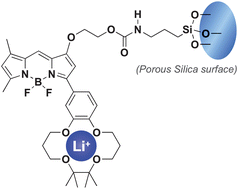This paper presents the preparation and characterization of a single-excitation, dual-emission ratiometric optical Li+-sensing device using a newly designed and synthesized highly Li+-selective fluoroionophore (KBL-01) carrying 14-crown-4 ether with tetramethyl and benzene blocking subunits as Li+-binding site and boron-dipyrromethene as fluorophore. The indicator dye was covalently immobilized on the surface of a porous glass support having a large internal surface area using a silane-coupling agent. The resulting Li+-selective glass optode shows dual fluorescence emission response in pseudo-serum at varying Li+ concentrations, allowing ratiometric signal processing. The obtained signal is independent of the presence of possibly interfering cations (Na+, K+, Mg2+ and Ca2+) and pH. The sensor response was found to be reversible within the Li+ concentration range from 10−4 to 10−1 M, and showed good repeatability and light stability. The plots of the ratiometric signal versus the Li+ concentrations in spiked real human serum go along with the response curve in pseudo-serum. These results indicate that the novel Li+-selective glass optode can be employed as a Li+-sensing device with high durability, sensitivity and accuracy for medical analyses.

You have access to this article
 Please wait while we load your content...
Something went wrong. Try again?
Please wait while we load your content...
Something went wrong. Try again?


 Please wait while we load your content...
Please wait while we load your content...